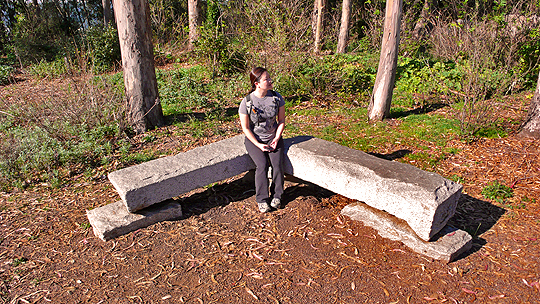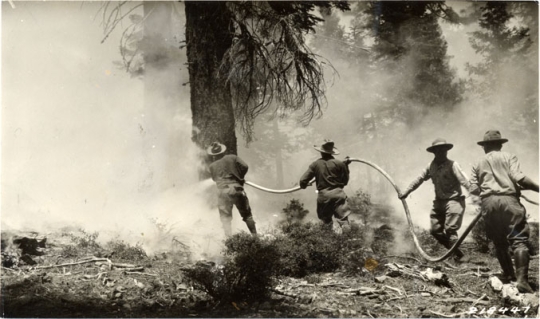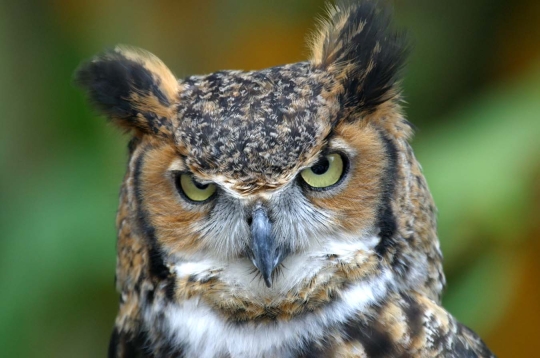
At first I was a little ashamed that I’d never been in the forest on Mount Sutro, officially known as the Mount Sutro Open Space Reserve, even after living in the city for almost 14 years. But, after asking around, I discovered most of my long-time-resident friends haven’t been there either. So now it’s their turn to feel ashamed. (More after the jump.)
I was tipped off to the the Rotary Club’s native plant meadow – located on top – by Amber Hasselbring, who’d guided me on a free botany walk up Twin Peaks a few weeks back.
[Before you visit, be sure to check out the really well-executed map of Mount Sutro (PDF).]
With the meadow as the destination, my girl Charin and I hopped on the N-Judah at Duboce, slipped through the tunnel, got off at UCSF. Behind one of the buildings is a sleek new staircase that leads to a network of well-tended trails. It was a quick hike to the peak, with some nice chert rock outcroppings looming right off the path.

At the top is the meadow, a rich oasis of native grasses, flowers, and shrubs amidst the paradox-inducing blue gum eucalyptus trees (they create a beautiful forest, yet are not sustainable).

It was Adolf Sutro himself who planted the forest prior to his term as mayor in 1886, which he meant as a local renewable source of lumber. It suffered a history of fires (it remains such a hazard today) and other weird occurrences.

The forest continues to be a source of contention between well-meaning groups, some of whom want to thin the forest of the non-native trees, and others who don’t want to lose the ecosystem that exists now, which is unique and beautiful and provides cover for many native and non-native plants, plus animal species such as the great horned owl.
Where do you come down on the issue? Let us know in the comments.



It’s exciting to discover this as a natural place to explore in the city. I’ll have to make plans to visit soon – as a recent rural transplant, I’m starved for some greenery.
This looks like an amazing find and I can’t wait to go on an urban hike.
It makes no sense to try to create a few acres of “native habitat” in the middle of a city. What could it accomplish other than the destruction of what exists now?
michael, i’m relatively new to the idea of native plant species and their value, but from what i’ve had explained to me by folks like Amber and Iris, when native plants thrive they support a more robust diversity of other species, including insects and birds, which then support other species in the local food chain.
when non-native plants dominate, there tends to be less of this diversity, and lower stability among the existing species. even worse, many of the non-natives are invasive and require drastic damage-control, which itself causes further damage.
nonetheless, i’m not an absolutist on this, since the land we’re on has been irrevocably changed, and often our best-intentioned actions have consequences that can be self-defeating. i embrace a certain type of existentialism that tries to respect this paradox, and in that spirit, i can appreciate the absolutists on both sides.
I’m declaring my own biases – I’m one of those trying to preserve the ecosystem that’s there now. Two points: One, there’s no evidence that native plants support more species. There are more species of birds in the forest than on Twin Peaks, for instance. A lot of myths have been spread about eucalyptus, but as you will see in this beautiful cloud forest, there’s a thriving ecosystem there already. We’ve recorded over 40 species of birds there.
http://sutroforest.com/2010/03/29/sutro-forest-birds/
Two, keeping a dense, established century-old forest in place actually increases the biodiversity of the area.
http://sutroforest.com/2010/05/07/protecting-sutro-cloud-forest-helps-biodiversity/
On a foggy day, this forest is probably the most beautiful place to visit in all San Francisco. (Be prepared for mud, though!)
http://sutroforest.com/2010/08/08/mount-sutro-forest-a-walk-in-the-fog/